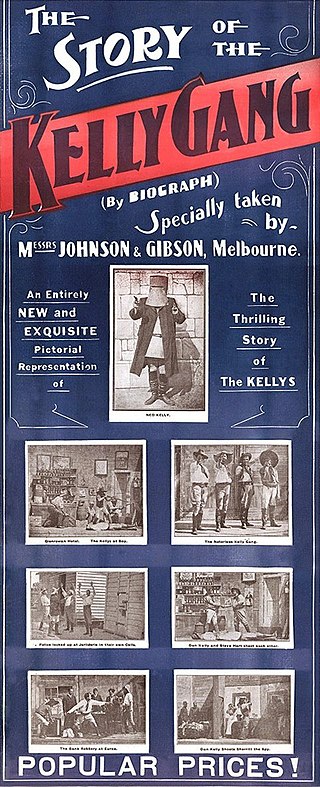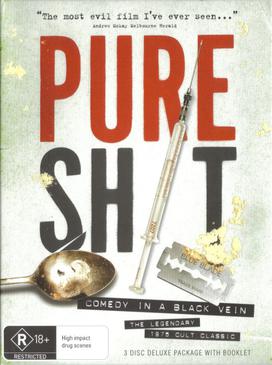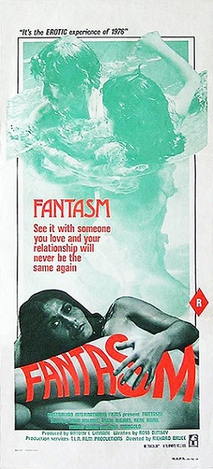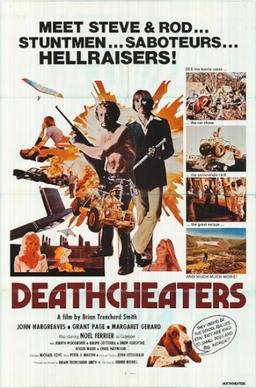Related Research Articles

The cinema of Australia began with the 1906 production of The Story of the Kelly Gang, arguably the world's first feature film. Since then, Australian crews have produced many films, a number of which have received international recognition. Many actors and filmmakers with international reputations started their careers in Australian films, and many of these have established lucrative careers in larger film-producing centres such as the United States.

The Story of the Kelly Gang is a 1906 Australian Bushranger film directed by Charles Tait. It traces the exploits of 19th-century bushranger and outlaw Ned Kelly and his gang, with the film being shot in and around Melbourne. The original cut of this silent film ran for more than an hour with a reel length of about 1,200 metres (4,000 ft), making it the longest narrative film yet seen in the world. It premiered at Melbourne's Athenaeum Hall on 26 December 1906 and was first shown in the United Kingdom in January 1908. A commercial and critical success, it is regarded as the origin point of the bushranging drama, a genre that dominated the early years of Australian film production. Since its release, many other films have been made about the Kelly legend.
Timothy Burstall AM was an English Australian film director, writer and producer, best known for hit Australian movie Alvin Purple (1973) and its sequel Alvin Rides Again (1974).
The Melbourne International Film Festival (MIFF) is an annual film festival held over three weeks in Melbourne, Victoria, Australia. It was founded in 1952 and is one of the oldest film festivals in the world following the founding of the Venice Film Festival in 1932, Cannes Film Festival in 1939 and Berlin Film Festival in 1951.

The Fugitive is a 1993 American action thriller film, directed by Andrew Davis with a script co-written by Jeb Stuart and David Twohy, from a previous story draft which Twohy had written. Based on the 1960s television series of the same name, the film stars Harrison Ford, Tommy Lee Jones, Sela Ward, Joe Pantoliano, Andreas Katsulas, and Jeroen Krabbé.

Alvin Purple is a 1973 Australian sex comedy film starring Graeme Blundell in the title role; the screenplay was written by Alan Hopgood and directed by Tim Burstall, through his production company Hexagon Productions and Village Roadshow.

Cinesound Productions Pty Ltd was an Australian feature film production company. Established in June 1931, Cinesound developed out of a group of companies centred on Greater Union Theatres that covered all facets of the film process, from production to distribution and exhibition. Cinesound Productions established a film studio as a subsidiary of Greater Union Theatres Pty Ltd based on the Hollywood model. The first production was On Our Selection (1932), which was an enormous financial success.

From Beyond is a 1986 science-fiction body horror film directed by Stuart Gordon, loosely based on the short story of the same name by H. P. Lovecraft. It was written by Dennis Paoli, Gordon and Brian Yuzna, and stars Jeffrey Combs, Barbara Crampton, Ken Foree and Ted Sorel.
Cthulhu is a 2000 Australian low budget horror film that was directed, produced, and written by Damian Heffernan. It is mostly based on two Lovecraft stories, "The Thing on the Doorstep" and The Shadow Over Innsmouth. It stars Adam Somes as a young student that discovers that his best friend has become involved in a cult intent on raising Cthulhu. It screened at the Melbourne Underground Film Festival, after which point it was purchased by Channel 9 for screening in Australia as part of their Australian content quota obligations. The film was also purchased by Trend Films in Italy for screening via their Satellite Television network.
Clay is a 1965 Australian drama film directed by Giorgio Mangiamele. The film was nominated for the Golden Palm award at the 1965 Cannes Film Festival, but it lost to The Knack ...and How to Get It.

Pure Shit is a 1975 Australian drama film directed by Bert Deling.
Stork is a 1971 Australian comedy film directed by Tim Burstall. Stork is based on the play The Coming of Stork by David Williamson. Bruce Spence and Jacki Weaver make their feature film debuts in Stork, being honoured at the 1972 Australian Film Institute Awards, where they shared the acting prize. Stork won the prize for best narrative feature and Tim Burstall won for best direction. Stork was one of the first ocker comedies. Stork was the first commercial success of the Australian cinema revival called the Australian New Wave.
27A is a 1974 Australian drama film directed by Esben Storm. At the AFI Awards it won in the Best Actor and Best Fiction categories.
The Naked Bunyip is a 1970 Australian documentary film directed by John B. Murray. The film explores sex in Australia using a fictional framework.
The Silence of Dean Maitland is a 1934 Australian film directed by Ken G. Hall, and based on Maxwell Gray's 1886 novel of the same name. It was one of the most popular Australian films of the 1930s.

Strike Me Lucky is a 1934 Australian comedy musical film starring popular stage comic vaudevillian Roy Rene in his first and only film. It was the fourth feature film from Cinesound Productions but proved a box office disappointment. Director Ken G. Hall claimed it was the only one of his features not to go into profit within a few years of release, although the film eventually covered costs.

Lovers and Luggers is a 1937 Australian film directed by Ken G. Hall. It is an adventure melodrama about a pianist who goes to Thursday Island to retrieve a valuable pearl.
Giorgio Mangiamele was an Italian/Australian photographer and filmmaker who made a unique contribution to the production of Australian art cinema in the 1950s and 1960s. His films included Il Contratto (1953), The Spag (1962), Ninety Nine Per Cent (1963) and Clay (1965). Clay was selected for competition at the Cannes Film Festival in 1965.

Fantasm is a 1976 Australian softcore pornographic film, directed by Richard Franklin under a pseudonym. It was followed by a sequel, Fantasm Comes Again, the following year, directed by a pseudonymous Colin Eggleston.

Deathcheaters is a 1976 Australian action adventure film directed by Brian Trenchard-Smith and starring John Hargreaves and Grant Page.
References
- 1 2 3 Andrew Pike and Ross Cooper, Australian Film 1900–1977: A Guide to Feature Film Production, Melbourne: Oxford University Press, 1998 p249
- ↑ David Stratton, The Last New Wave: The Australian Film Revival, Angus & Robertson, 1980 p275
- ↑ Graeme Cutts, "Giorgio Mangiamele", Cinema Papers, October 1992 p21
- ↑ Quentin Turnour, 'Giorgio', Senses of Cinema, 13 June 2001 accessed 18 Sept 2012